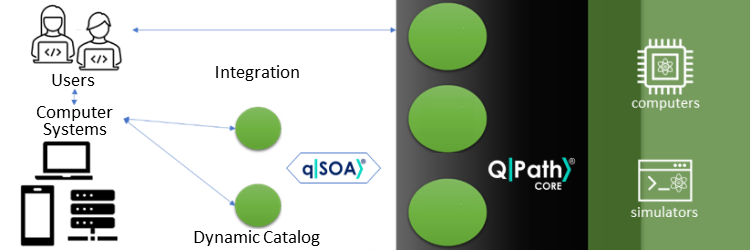Motivated by the release of qSOA® v.2, the QuantumPath® architecture designed for the integration of quantum software and classical IT through ConnectionPoint and its open standards-based protocols, José Luis Hevia, Mario Piattini and Guido Peterssen, members of aQuantum, have co-authored the article entitled “qSOA®: technology for dynamic integration of quantum-classical hybrid software systems”, published in The QPath® Blog.
In the article the authors consider, taking into account the current state of the art of quantum technologies, that quantum computers and their potential services are at the deepest layer of the IT infrastructure, and this determines the way in which the design and operations of software product architectures must be conceived.
In this context, to be able to access quantum services in a centralized way, the computing principle does not change: we need an access through a communications network, an access protocol to the services of the new system and to apply best practices at all levels of access (security, traceability, governance…) that have already been in place and well-tested for a long time.
QuantumPath® is a platform that offers everything needed for the design and construction of hybrid quantum solutions. For this, QuantumPath® provides qSOA®, a technology that is positioned at the service layer of a computer system, allowing the quantum services platform to be exploted via an API, with which a classical system can access quantum products as if they were just another piece of classical software. But that’s not all: from qSOA® it is also possible to interact with the quantum platform to define new quantum products in a totally dynamic way and adapted in real time to actual problems.
The article describes the most important elements of the evolution of qSOA® up to version 2, highlighting that qSOA® V2 incorporates automatic access to the life cycle of the asset itself, i.e., being able to dynamically expand the catalog of assets (circuits and dynamic flows), controlling their states, compilations and transpilations in a fully automatic way) through the computer systems that act as clients and overcome the design barriers in terms of qubit resolution.
In addition to the fundamental elements of the qSOA® architecture, the article presents an example of using the qSOA® API through a use case, a QRNG (quantum random number generator based on gate technology) type algorithm.
The authors conclude that qSOA® and QuantumPath® facilitate the implementation of hybrid software systems in a reliable, fast way and based on the best principles of computer engineering, providing the industry with the ability to have practical solutions to access the benefits of quantum computing.
The aQuantum Team congratulates Pepe, Mario and Guido for the publication of this article.
You can see all the articles and other papers published by aQuantum here.


Recent Comments